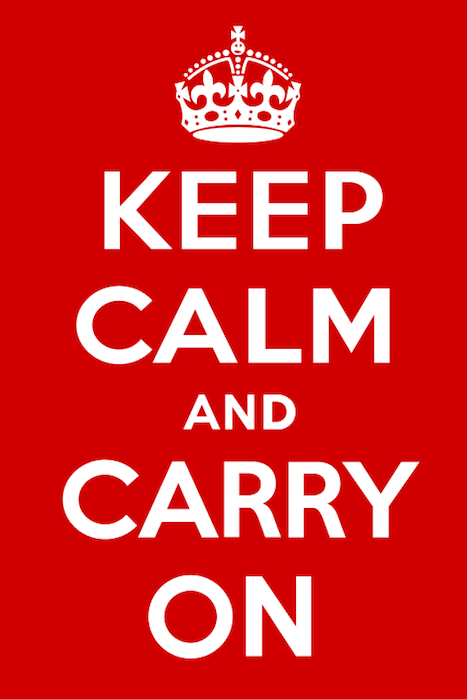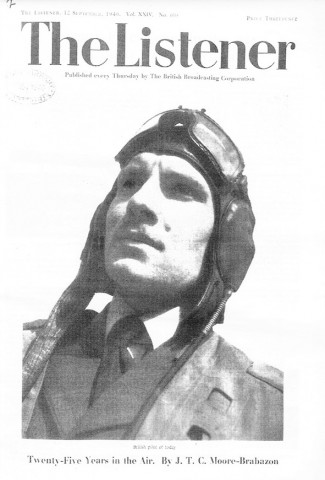
The Guardian has published a very interesting piece by Owen Hatherley on the ‘Keep Calm and Carry On’ phenomenon, an extract from his new book, The Ministry of Nostalgia: Consuming Austerity. He persuasively locates the poster within the context of an ‘austerity nostalgia […] a yearning for the kind of public modernism that, rightly or wrongly, was seen to have characterised the period from the 1930s to the early 1970s; it could just as easily exemplify a more straightforwardly conservative longing for security and stability in hard times’. I’m not British, but from the outside this seems like a plausible explanation for the renewed interest in the Blitz spirit in recent times.
But that’s not what I’m concerned with here. Instead I’m going to pedantically focus on Hatherley’s explanation of the original context of ‘Keep Calm’. He rightly notes that it was one of three posters designed in the months before the start of the Second World War, and that of the three it was the only one which was not actually displayed in public. But the description he gives of the motivation for ‘Keep Calm’ is not correct. This is what he says (emphasis added):
The specific purpose of the poster was to stiffen resolve in the event of a Nazi invasion, and it was one in a set of three. The two others, which followed the same design principles, were:
YOUR COURAGE
YOUR CHEERFULNESS
YOUR RESOLUTION
WILL BRING
US VICTORYand:
FREEDOM IS
IN PERIL
DEFEND IT
WITH ALL
YOUR MIGHTBoth of these were printed up, and “YOUR COURAGE … ” was widely displayed during the blitz, given that the feared invasion did not take place after the German defeat in the Battle of Britain […] Of the three proposals, KEEP CALM AND CARRY ON was discarded after the test printing. Possibly, this was because it was considered less appropriate to the conditions of the blitz than to the mass panic expected in the event of a German ground invasion.
Three times, Hatherley refers to a German ground invasion. This was certainly expected in the summer and autumn of 1940, and had it actually taken place ‘Keep Calm’ (or something like it) may well have been revived in an attempt to calm nerves as Hitler’s panzers rolled towards Charing Cross. But invasion was not expected before the outbreak of war when the posters were being drawn up, or indeed before the defeat of France. Unlike before 1914, before 1939 little thought was given to the possibility of invasion, whether by the government or in the public sphere.
The reason why the government was so concerned about the possibility of a collapse in civilian morale in wartime was primarily, of course, because of the almost axiomatic assumption that the next war would begin with massive air raids aimed at London and other cities, air raids which could not be prevented from causing massive casulties within a short time — in order words, an attempted knock-out blow from the air which would shock people into defeatism and even rebellion. There were certainly other contingencies in which ‘Keep Calm’ might have been deployed: a successful U-boat blockade, say, or a Communist uprising, or even, yes, in extremis an invasion. But these were second-order concerns at the time.
This is clear from the amount of effort put into (sometimes literally) concrete defence systems. There were practically none to guard against an invasion from the sea, which is why from May 1940 anti-invasion defences had to be hurriedly thrown together, such as the Local Defence Volunteers (later Home Guard), pillboxes and tank traps on the beaches, and the GHQ Line of fortifications across the middle of England. This is in stark contrast to Britain’s air defence system and air raid precautions (ARP) services, both of which were quite sophisticated and had been built up for years before the war began (though less so in the case of ARP, perhaps). These differing degrees of preparedness make sense when the differing degrees of risk are considered. The existence of France’s army and Britain’s navy made a German excursion across the North Sea a very risky one. By contrast, the Luftwaffe had many bombers and, no matter the defences, most of them could be expected to get through and devastate London.
I don’t know what Hatherley’s sources are, but he’s not the only one to make this mistake — even though Wikipedia gets it right (‘The poster was intended to raise the morale of the British public, threatened with widely predicted mass air attacks on major cities’). Generally speaking, this is because 1940 trumps 1939: the memory of the Blitz has erased the memory of the knock-out blow. This is not all that surprising, since the Blitz actually happened while the knock-out blow didn’t. But it does make it hard to grasp the sheer difference in scale and in intensity between the real holocaust and the expected one, which should have been much, much worse, if the prewar calculations were any guide. (Of course, they weren’t.) Conversely, it’s forgotten how unexpected the Blitz spirit was, so that it’s hard to understand why the government might print nearly 2.5 million copies of a poster in a desperate attempt to support civilian morale. And so memory misunderstands ‘Keep Calm’. It wasn’t created for an age of austerity at all, but for an age of terror. Which is perhaps even more appropriate, come to think of it.
Image source: Wikimedia.
![]() This work is licensed under a Creative Commons Attribution-NonCommercial-NoDerivatives 4.0 International License.
Permissions beyond the scope of this license may be available at http://airminded.org/copyright/.
This work is licensed under a Creative Commons Attribution-NonCommercial-NoDerivatives 4.0 International License.
Permissions beyond the scope of this license may be available at http://airminded.org/copyright/.




Good post, Brett. I’d also add that Owen Hatherley’s another gap in his assessment, later on. It’s a very different topic, but a similar error, I’d argue. He misses that Jamie Oliver, by naming his food initiative ‘Ministry of Food’ was critically taking advantage of the ‘Ministry of Sound’s cool status in the 1990s and 2000s as much as the 1940s ‘Ministry of Food’, which would be well off the age horizon for the people Jamie’s effort was aimed at. One can argue how much, that’s critical but not mentioning it at all is to miss one key reason why the name was viable. It’s a good article, but loads too much on ‘see this all relates to austerity’ for my liking. Unsurprisingly, I’d suggest it’s more complex than that.
A bit more context on the “Keep Calm” story is given by a letter in today’s Guardian: http://www.theguardian.com/artanddesign/2016/jan/13/the-full-story-behind-wartime-keep-calm-and-carry-on-posters.
The fact that two million plus were printed but pulped as of April 1940 is a pretty solid indication that they hadn’t been produced with invasion in mind.
Good find, Nick, thanks.
JDK:
I must confess to not being very familiar with either the Ministry of Sound or Jamie Oliver’s Ministry of Food, but it sounds plausible. You’re probably right that there’s more going on than just austerity. For one thing, Keep Calm was popular before austerity came along.
Nick:
Thanks — the link provided there is also worth following, to here.
I’m certainly the last person to ask about night clubs post 1930! But there’s enough online to provide social context, I think. Given that the ‘Ministry of Food’ effectively is a counter to state shortfall and from a particular individual, there has to be layers of irony intended in the name.
Pingback: Acquisitions – Airminded